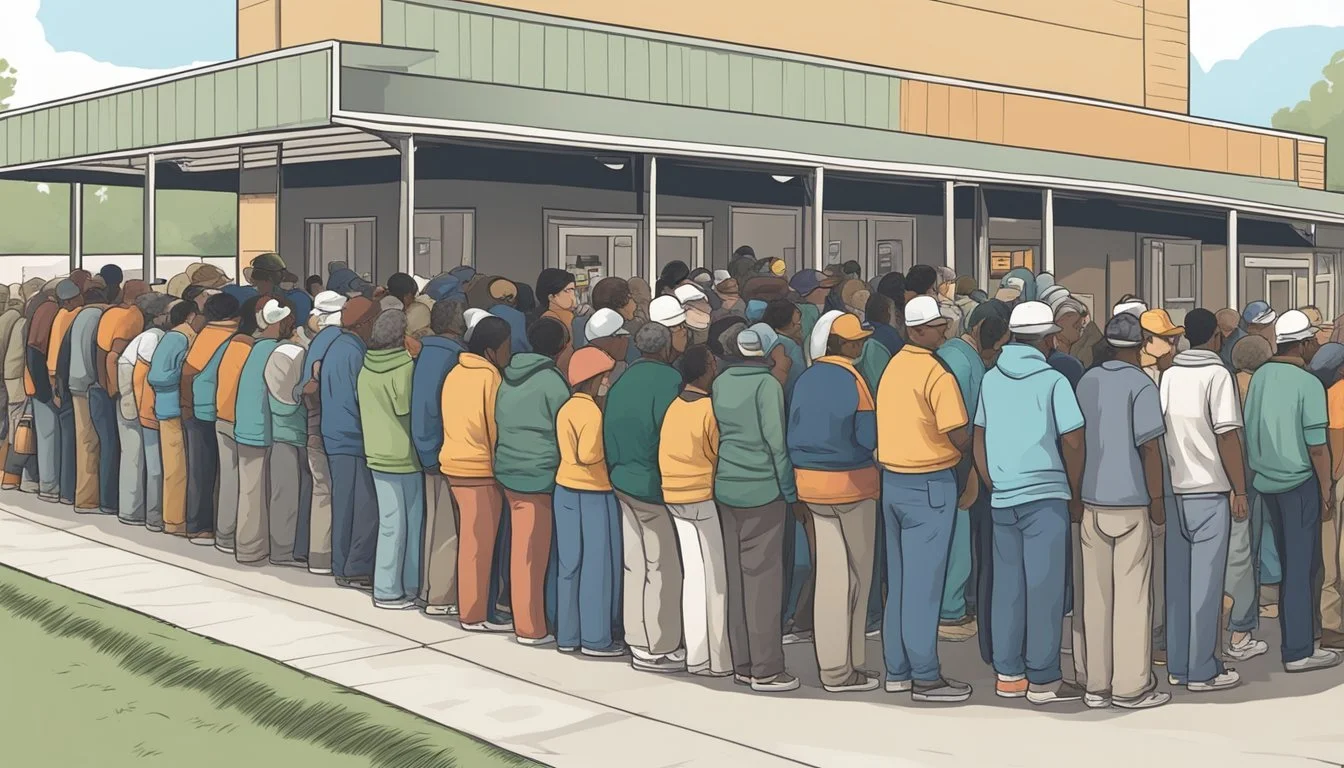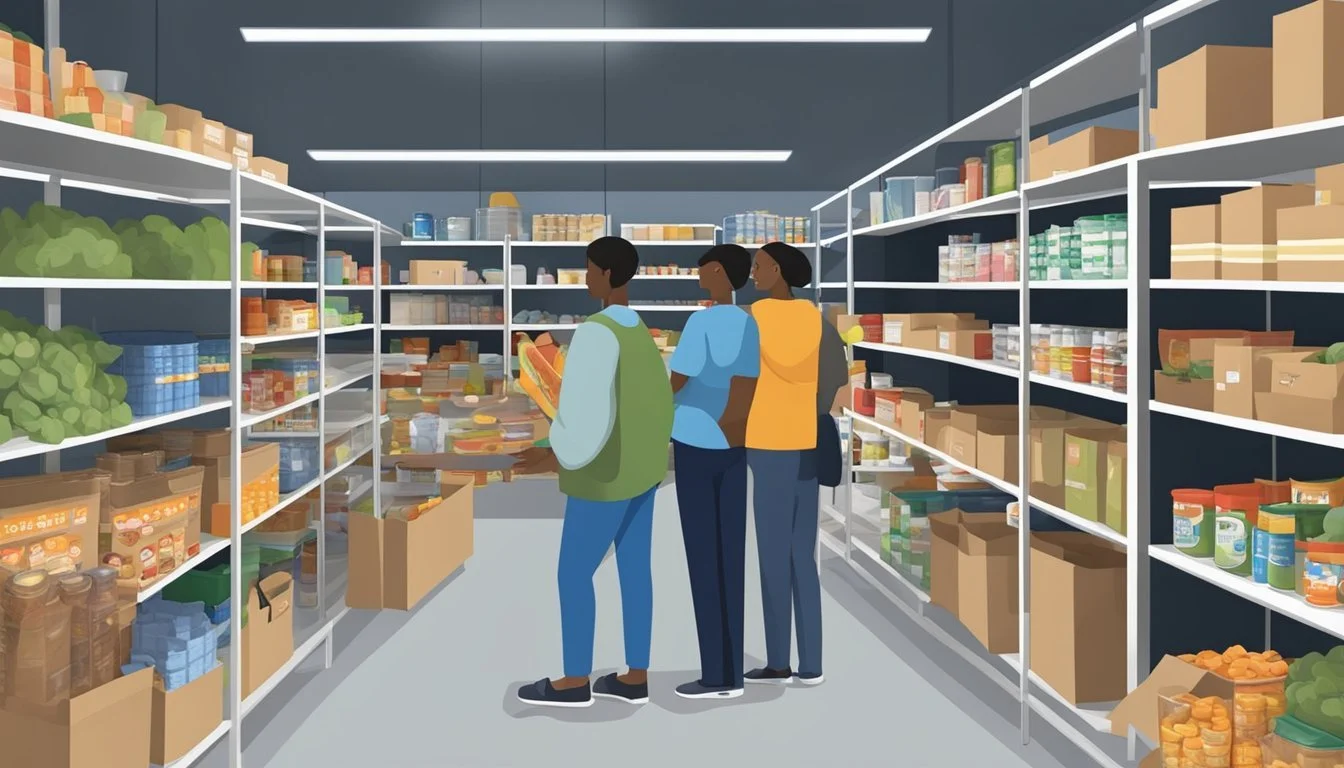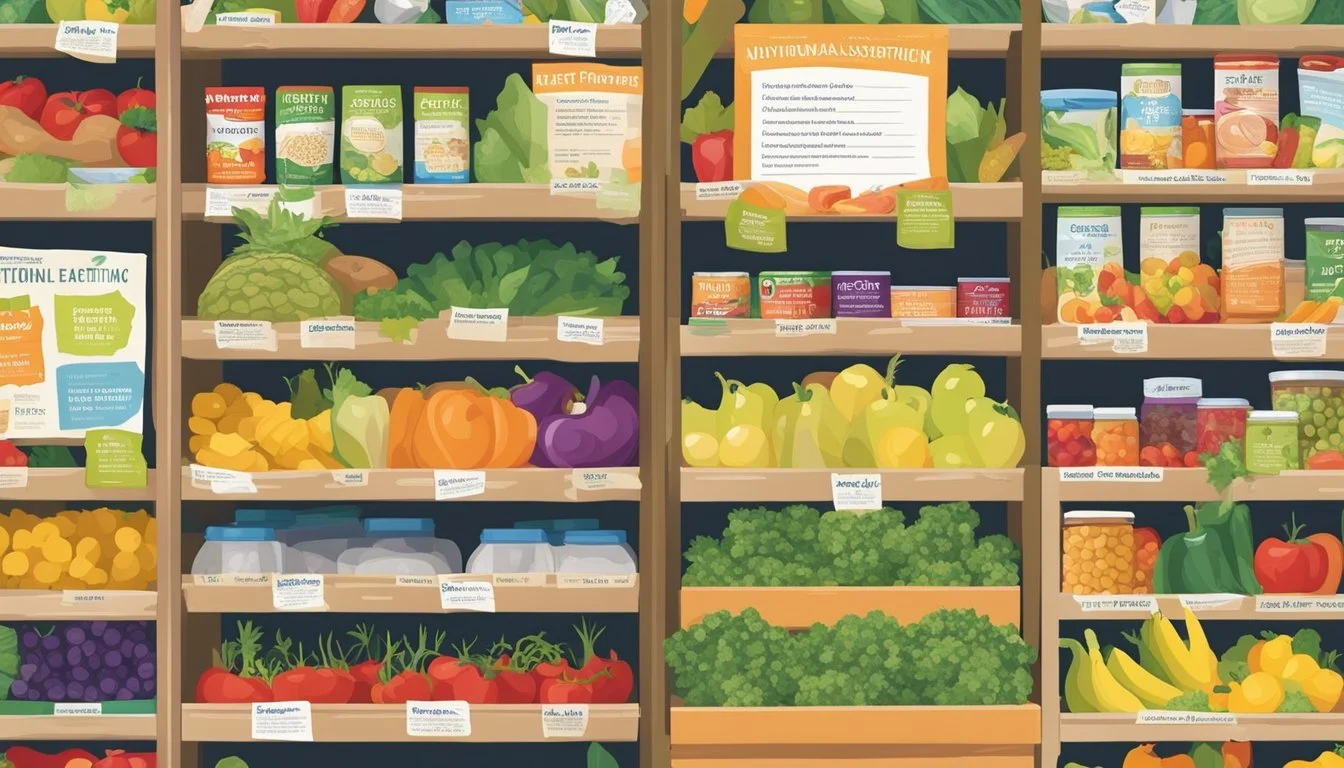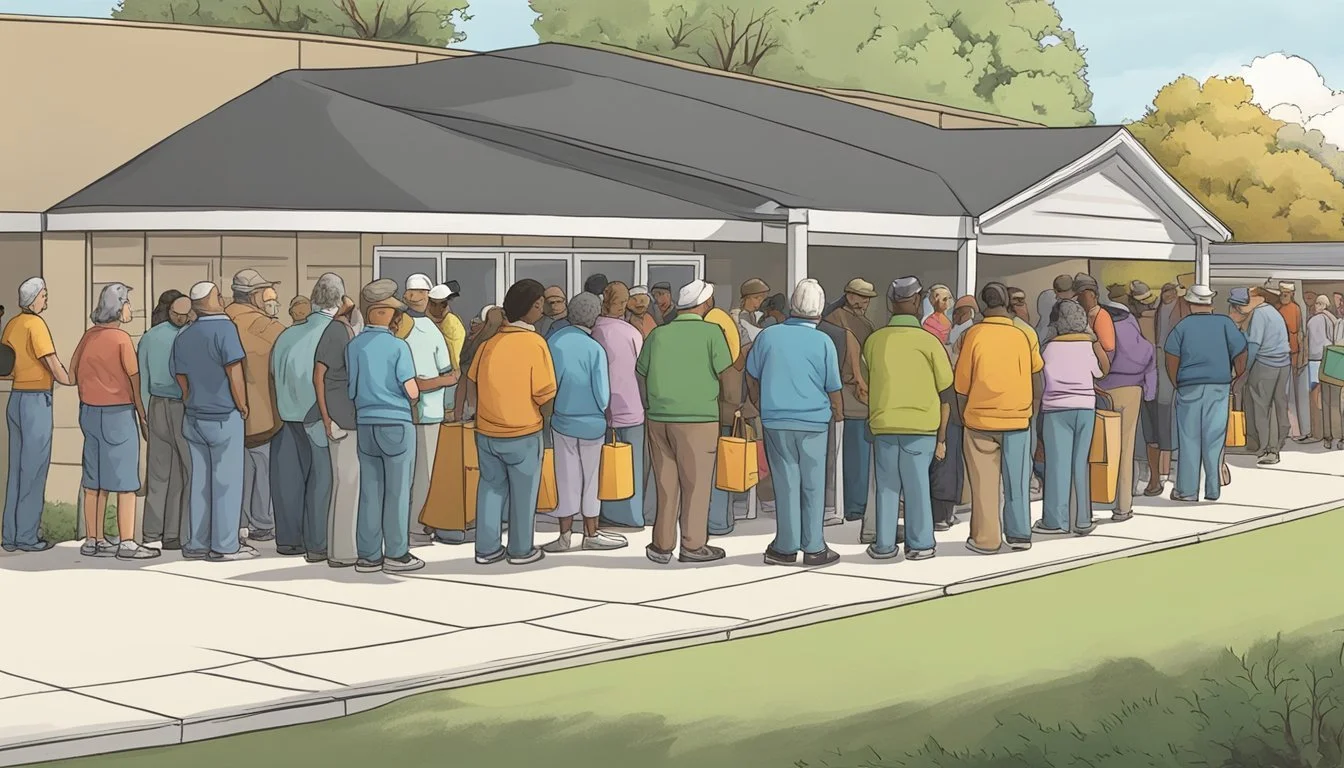Free Groceries and Food Pantries in Jefferson County, Texas
Your Essential Guide
This Article is Part of Our Guide on Free Groceries in Texas
Access to nutritious food is a fundamental need and a challenge for many families and individuals facing food insecurity. In Jefferson County, Texas, a network of food pantries, churches, and charitable organizations have established various programs to provide free groceries and other essentials to those in need. These services are essential for supporting the community, as they ensure that no one has to go without basic food supplies, regardless of their financial situation.
The food assistance landscape in Jefferson County is diverse, with multiple locations offering aid across the region. Emergency food pantries offer immediate relief by supplying a range of food items and, in some cases, additional necessities like clothing and housewares. Moreover, structured programs such as SNAP (Supplemental Nutrition Assistance Program) provide long-term support to qualifying individuals and families.
As the need for food assistance remains a pressing issue, these resources in Jefferson County seek to empower residents and alleviate the stress of food scarcity. The pantries operate on various days of the week to maximize accessibility for those with differing schedules. Driven by the community, these initiatives demonstrate a strong commitment to ensuring food security for all residents.
Understanding Food Insecurity in Jefferson County
In Jefferson County, Texas, food insecurity signifies a critical challenge faced by the community, especially among low-income households. Individuals experiencing food insecurity lack consistent access to enough food for a healthy life. This issue affects a spectrum of residents, from children to the elderly, and is a significant concern for local non-profits and charities aiming to meet the basic needs of the population.
Key Aspects of Food Insecurity:
Prevalence: Despite the efforts of various organizations, a substantial portion of Jefferson County residents face food shortages regularly.
Impact on Low-Income Families: Financial constraints often force these families to choose between necessary expenses and purchasing adequate food.
Charitable Response: Non-profits and food pantries play a crucial role in providing free groceries to those in need, although resources may be stretched.
Statistics in Jefferson County:
Year Households Below Poverty Line Households Receiving SNAP Benefits 2021 6.8% 4.4%
Food insecurity is a complex issue where economic factors and access challenges intertwine. Charitable organizations, along with community efforts, strive to mitigate this by distributing food and offering meals. While these efforts are noteworthy, the sustainability of food systems remains a priority for ensuring long-term solutions. By enhancing policy strategies and developing food distribution networks, Jefferson County continues to combat the adversities of food insecurity.
Identifying Local Food Resources
In Jefferson County, Texas, residents in need have access to an array of resources aimed at combating hunger, including well-stocked food pantries, soup kitchens that provide hot meals, and emergency food assistance programs. These resources, supported by community efforts, charity organizations, and federal aid, are crucial in meeting the nutritional needs of various demographics within the community.
Jefferson County Food Pantries
Food pantries in Jefferson County provide essential groceries to families and individuals. The Eagles Wings Food Pantry, for example, operates on the first and third Wednesdays of each month, supplying goods to Jefferson County residents in need. Details such as operation hours, location, and contact can be easily found by searching through local directories or community resource listings.
Soup Kitchens in the Area
Local soup kitchens, such as those managed by churches or community groups, offer immediate relief by serving hot meals to the homeless and working poor. These facilities rely on volunteers and donations to operate, ensuring that individuals facing hunger can find solace and nutrition regardless of their situation.
Free Grocery Programs
Programs offering free groceries seek to alleviate the strain on those struggling to purchase food. These initiatives may follow a schedule for distribution or operate as part of an emergency service. Furthermore, entities like Feeding America are instrumental in providing support to food banks and grocery programs within the county.
Emergency Food Assistance
During times of crisis, emergency food assistance becomes vital. Organizations pivot to offer expedited services to those affected by sudden hardships. Networks of food banks and charities collaborate to ensure that aid is dispersed promptly and effectively to where it is most needed.
Assistance Programs and Charities
Charities and assistance programs such as the Salvation Army and United Board of Missions offer considerable support, including food aid, to individuals and families. These programs may also extend to include clothing, financial assistance, and household supplies, reflecting a holistic approach to supporting community members in distress.
Community and Church Outreach Initiatives
Churches and community centers often organize outreach initiatives, providing food, personal hygiene supplies, and a sense of belonging. Their mission typically encompasses supporting the spiritual and physical well-being of their community members.
Nutrition Programs for Specific Needs
Specific demographics such as children, the elderly, and pregnant women may have unique nutritional needs. Programs like WIC and supplemental nutrition programs through SNAP food stamps ensure that baby formula and other specialized food items are accessible to those who qualify.
Seasonal Food Programs
Holidays like Christmas, Easter, and Thanksgiving may prompt seasonal food programs, where community gatherings and charitable events focus on sharing meals and distributing food baskets to ensure that all community members can celebrate these special occasions without scarcity.
Additional Aid Services
Beyond food, some aid services offer a more comprehensive range of assistance. This may include personal hygiene items, household necessities, or even financial guidance and support, all of which can contribute to overall stability and well-being.
Food Distribution Events and Locations
Food distribution events are regularly organized within the county, available at various locations to reach as many residents as possible. Information about these events is often disseminated through local networks and can be located by zip code search or through community bulletins.
Resources for Special Demographics
Resources tailored for special demographics address the unique challenges faced by families, children, the elderly, and the homeless. Access to these resources ensures that vulnerable groups receive the appropriate assistance to meet their dietary and basic needs.
Federal and State Level Support
Federal and state support programs provide public aid, reinforcing local efforts to combat hunger. These programs offer structured support based on income levels and other qualifying factors, with clear guidelines for eligibility and application processes.
Understanding Eligibility and Access
Eligibility for different food aid programs is typically determined by state guidelines, income levels, and household size. It's important to understand the access points for these services, which may require documentation and potentially an application process.
Connecting with Volunteers and Donors
Volunteers and donors form the backbone of food assistance programs. They are essential in the collection, organization, and distribution of food and supplies. For those looking to contribute, local charities and food banks consistently welcome new volunteers and appreciate any donations that help sustain their mission.
Steps to Access Free Food and Pantries
In Jefferson County, Texas, residents who face food insecurity have access to various food banks and pantries. By following clear steps, individuals and families can obtain the sustenance they need.
Locating Nearby Food Banks and Pantries
Residents can locate their nearest food banks and pantries by utilizing the Feeding America website. They should enter their zip code or state to find a list of local food assistance options.
Feeding America Network: Connect to local resources by visiting Feeding America.
Hours of Operation and Contact Information
It's crucial to note the operating hours and contact information of the chosen food pantry. For instance, the Abundant Life Sanctuary holds distributions on the last Saturday of each month from 8:00 a.m. to 10:00 a.m.
Southeast Texas Food Bank Agencies: A full list with contact details can be sourced through their network, which collaborates with various agencies.
What to Expect and Bring
When visiting food banks and pantries, individuals should bring identification and proof of income, as some locations may require these. They should expect to possibly stand in line and be prepared to select their own groceries based on availability.
Required Items: Often, ID and proof of income
Selection Process: Typically self-service with a 'take what you need' policy
Navigating Emergency Food Situations
In the event of an emergency or immediate need for food, individuals may seek assistance from local emergency shelters or respite centers. These centers often provide a more immediate distribution of food and support.
Immediate Help: Contact local emergency shelters or respite centers for urgent food needs.
Engaging with Local Support Networks
Local community networks are a substantial support system for those seeking food assistance. Establishing contact with local charities, churches, and non-profit organizations often leads to discovering various forms of aid.
Community Resources: Churches and charities in Jefferson County can be essential for ongoing support.
By understanding these steps and utilizing local resources, residents of Jefferson County, Texas, can access the food assistance they need through a structured and supportive network.
Program Profiles
Jefferson County, Texas, is supported by several food assistance programs and nonprofits. These entities work tirelessly to ensure that no resident faces hunger without access to support. Below are profiles of key programs and organizations within the county.
Southeast Texas Food Bank
The Southeast Texas Food Bank operates in partnership with local agencies to distribute food across Jefferson County. They help residents through various programs, including sourcing from the Emergency Food Assistance Program (TEFAP) and hosting drive-thru pantries. Residents can schedule appointments for assistance.
Salvation Army of Mid & South Jefferson County
Located at 3145 25th Street in Port Arthur, the Salvation Army provides essential services beyond just food assistance. They offer groceries, hot meals, and bill payment help to those in need.
United Board of Missions
This organization provides critical support to the less fortunate in Port Arthur and the surrounding communities. Among its services, food assistance is a cornerstone, helping to alleviate hunger throughout Mid and South Jefferson County.
Church-led Initiatives
Various churches, including Val Verde Baptist Church, St. James United Methodist Church, and Central City Baptist Church, offer food pantries and assistance on designated days of the month. These initiatives allow community members to receive free groceries and meals alongside spiritual support.
Emergency Food Assistance Program (TEFAP)
TEFAP is a federal program that helps supplement the diets of low-income Americans by providing them with emergency food assistance at no cost. Local organizations, supported by the Southeast Texas Food Bank, ensure the distribution of these essential commodities.
Community Soup Kitchens and Hospitality Centers
Places like the Hospitality Center and local soup kitchens provide not only nutritious meals but also a community space for those who may not have a stable residence or those who struggle with isolation in addition to food insecurity.
Abundant Life Sanctuary Nutritional Services
Abundant Life Sanctuary offers dietary and nutritional services that include food assistance to individuals in the community. Through these services, they cater to both the physical and spiritual well-being of Jefferson County residents.
Other Notable Charities and Non-profits
Organizations like Some Other Place provide a range of services from housing to food aid. Various other non-profits, including churches like New Day Deliverance Holiness Church, contribute to the network of free food distribution ensuring comprehensive coverage across the county.
Nutritional Information and Education
Food pantries in Jefferson County not only provide access to free groceries but also extend nutritional education and support to ensure beneficiaries make informed food choices and utilize pantry items effectively. This assistance aims to encourage healthy eating habits, improve meal planning skills, and enhance overall wellness through nutrition-focused workshops.
Healthy Eating with Food Pantry Items
Beneficiaries of Jefferson County food assistance programs can expect to receive a variety of grocery items, including meats, rice, canned goods, and other staples. Food pantries prioritize offering nutritionally balanced food options that cater to healthy diets. For example, lean meats and canned goods rich in protein and low in sodium can help families maintain a balanced diet.
Staples often available at food pantries:
Meats: Chicken, beef, and sometimes fish
Rice: White, brown, and occasionally specialty grains
Canned goods: Vegetables, fruits, beans, and soups
Cooking and Meal Planning Assistance
Food pantries in Jefferson County may provide services such as cooking demonstrations and recipe distributions to assist beneficiaries in creating meals that are both nutritious and satisfying. These educational resources are designed to help individuals and families make the most of their grocery items, combining pantry staples into balanced, healthful meals.
Services for meal planning can include:
Recipe booklets that use common food pantry items
Guidance on creating meal plans that stretch pantry supplies
Tips for safe food storage and minimizing food waste
Nutrition Workshops for Beneficiaries
Comprehensive nutrition workshops are a service that some Jefferson County food assistance programs may offer. These workshops educate participants on the importance of nutrition and how to incorporate a variety of grocery items into their diets to support health and well-being. Workshops might cover topics like the benefits of whole grains, the importance of different protein sources, and reading nutrition labels to make informed food choices.
Workshop topics could feature:
Comparing nutritional values of different canned goods
Understanding and utilizing various meats for balanced meals
Incorporating versatile items like rice into a nutritious meal plan
Support and Collaboration
In Jefferson County, Texas, addressing food insecurity involves robust support and collaboration across various entities. It requires the participation of dedicated volunteers, the organization of food drives, symbiotic partnerships with local businesses, and alignments with state and federal agencies. These strategic connections are instrumental in creating a comprehensive network that effectively combats hunger.
Volunteer Opportunities
Volunteers form the backbone of food assistance programs in Jefferson County. Individuals can contribute their time at various local food pantries, helping with tasks such as sorting donations, preparing food packages, and distributing food to those in need. Prospective volunteers can contact food banks like the Southeast Texas Food Bank, or smaller pantries within their community to offer their support.
How to Organize Food Drives
Community members and organizations can make a significant impact by organizing food drives. The steps for setting up a food drive include planning the event, promoting it to ensure a wide reach, collecting the donations, and coordinating with local food banks for distribution. Detailed guidelines may be provided by organizations such as Feeding America, which can help streamline the process.
Collaborating with Local Businesses
Local businesses can play a crucial role through sponsorships, donations, or by acting as collection points for food drives. Establishing a consistent partnership with these businesses helps ensure a steady influx of resources that support food assistance programs and can help in the acquisition of fresh and healthy food options for the pantries.
Partnering with State and Federal Agencies
State and federal agencies offer various programs and grants to support local food banks. These collaborations can lead to increased funding and resources, thereby enabling these food banks to serve larger sections of the population. Agencies such as the USDA provide assistance and can be pivotal in addressing food scarcity within the community.
Multi-organization Efforts to Combat Hunger
Combining efforts across multiple organizations like churches, non-profits, and community groups leads to a more powerful and widespread fight against hunger. Programs like the Dream Center of SETX, mentioned in the search results, exemplify the strength of cooperative efforts. Such alliances work towards common goals, sharing resources and information to enhance overall efficiency and reach.
Future Challenges and Opportunities
The landscape for food aid in Jefferson County, Texas faces an evolving set of challenges and opportunities, shaped by dynamic community needs and the resources available to meet them. Food pantries and banks play a critical role in this ecosystem, with innovation and policy changes steering their future sustainability and effectiveness.
Trends in Community Needs and Resources
Community needs in Jefferson County are shifting, with an increase in demand for food assistance services. The food pantry's breadth of participation reflects a diverse support system, including involvement from local businesses and community groups. With these changes, resources must adapt, increasing the necessity for efficient distribution and targeted support.
Innovation in Hunger Relief Efforts
Innovation is fundamental in enhancing the operations of food pantries and banks. The integration of technology could streamline inventory management and distribution processes, ensuring that food aid is agile and responsive to the real-time needs of the community. Such initiatives underline the importance of adaptability to maintain an effective food assistance network.
Policy Changes and Its Effect on Food Aid
Policy shifts, such as the recent allocation of funds by Jefferson County's commissioners, demonstrate the governmental commitment to food security. Policy changes can significantly impact food aid efforts, potentially altering funding, regulatory constraints, and the strategic direction of food assistance services. Ongoing engagement with policy developments is crucial for food banks and pantries to navigate this changing landscape.
Sustainability of Food Pantries and Banks
The long-term viability of food assistance organizations like food pantries and banks hinges on continuous support and the strategic utilization of resources. Crisis events such as the COVID-19 pandemic underscore the necessity for resilience and the ability to rapidly scale operations in response to heightened demand. Sustainable practices are not just fiscal but also involve community engagement, volunteer involvement, and the cultivation of local partnerships.
Conclusion
Jefferson County in Texas provides an essential service to its residents through a variety of food assistance programs. These programs are readily available to support individuals and families facing food insecurity. Residents can access services on specific days of the week, ensuring that assistance is both timely and regular.
Southeast Texas Food Bank offers services by appointment and can be reached at (409) 724-0163.
Dream Center of SETX opens its doors on the 2nd and 3rd Thursdays and Saturdays of each month.
For urgent needs, Some Other Place Food Bank in Beaumont is accessible, and one might dial (409) 832-7976 for support.
Empowerment Church caters to the community on the 2nd and 4th Wednesdays monthly.
Val Verde Baptist Church in Groves helps on the first and third Tuesday each month, contactable at (409) 962-8463.
Jefferson County Community Ministries (JCCM) has a history of providing not just food support, but also clothing and shelter for those in emergency situations.
The commitment of these organizations, bolstered by community support and donations, ensures that residents of Jefferson County who find themselves in need can access free groceries and other essentials, reflecting a strong system of care and support within the community.









